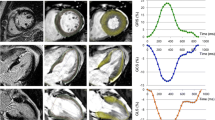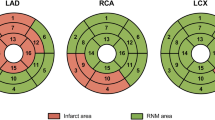Abstract
Cardiac magnetic resonance-tissue tracking (CMR-TT)-derived myocardial strain after ST-elevation myocardial infarction (STEMI) is related to adverse cardiac events. We aimed to investigate the feasibility of CMR-TT for the early prediction of adverse left ventricular (LV) remodeling after STEMI. We retrospectively searched our institution’s STEMI registry for patients who underwent reperfusion therapy, post-reperfusion CMR within 1 week after STEMI, and follow-up CMR. CMR-TT analysis was performed using cine imaging of post-reperfusion CMR. Adverse LV remodeling was defined as an increase in end-diastolic LV volume by 20% or more on follow-up CMR (median interval between serial CMR exams, 197 days; interquartile, 174–241 days). A total of 82 patients (age, 59.2 ± 11.1 years; male:female = 73:9) were included and divided into two groups: STEMI without (n = 62) and with (n = 20) adverse LV remodeling. Patients with LV remodeling showed significantly higher peak creatine kinase-MB and troponin I levels and a larger infarct size compared with those without LV remodeling (p = 0.001, p = 0.001, and p = 0.010, respectively). Global circumferential, radial, and longitudinal strain (GLS) also differed significantly between the groups (p = 0.001, p = 0.004, and p < 0.001, respectively). Logistic regression and receiver operating characteristic curve analyses demonstrated that GLS was an independent predictor of LV remodeling [odds ratio (OR) = 1.282, 95% confidence interval (CI) = 1.060–1.55 p = 0.011] with an optimal cut-off of − 12.84 (AUC = 0.756, 95% CI = 0.636–0.887, p < 0.001). CMR-TT-derived GLS may aid the early prediction of adverse LV remodeling after reperfusion, within 1 week after STEMI.



Similar content being viewed by others
References
Abbate A (2017) Tackling the Problem of Adverse Ventricular Remodeling After Myocardial Infarction. In: Morrow David A (ed) Myocardial Infarction: A Companion to Braunwald's Heart Disease. Elsevier, Missouri, pp 449–461
Konstam MA, Kramer DG, Patel AR, Maron MS, Udelson JE (2011) Left ventricular remodeling in heart failure: current concepts in clinical significance and assessment. JACC Cardiovasc Imaging 4(1):98–108
Park YH, Kang SJ, Song JK et al (2008) Prognostic value of longitudinal strain after primary reperfusion therapy in patients with anterior-wall acute myocardial infarction. J Am Soc Echocardiogr 21(3):262–267
Bochenek T, Wita K, Tabor Z et al (2011) Value of speckle-tracking echocardiography for prediction of left ventricular remodeling in patients with ST-elevation myocardial infarction treated by primary percutaneous intervention. J Am Soc Echocardiogr 24(12):1342–1348
D'Andrea A, Cocchia R, Caso P et al (2011) Global longitudinal speckle-tracking strain is predictive of left ventricular remodeling after coronary angioplasty in patients with recent non-ST elevation myocardial infarction. Int J Cardiol 153(2):185–191
Abate E, Hoogslag GE, Antoni ML et al (2012) Value of three-dimensional speckle-tracking longitudinal strain for predicting improvement of left ventricular function after acute myocardial infarction. Am J Cardiol 110(7):961–967
Munk K, Andersen NH, Terkelsen CJ et al (2012) Global left ventricular longitudinal systolic strain for early risk assessment in patients with acute myocardial infarction treated with primary percutaneous intervention. J Am Soc Echocardiogr 25(6):644–651
Altiok E, Tiemann S, Becker M et al (2014) Myocardial deformation imaging by two-dimensional speckle-tracking echocardiography for prediction of global and segmental functional changes after acute myocardial infarction: a comparison with late gadolinium enhancement cardiac magnetic resonance. J Am Soc Echocardiogr 27(3):249–257
Bergerot C, Mewton N, Lacote-Roiron C et al (2014) Influence of microvascular obstruction on regional myocardial deformation in the acute phase of myocardial infarction: a speckle-tracking echocardiography study. J Am Soc Echocardiogr 27(1):93–100
Kalam K, Otahal P, Marwick TH (2014) Prognostic implications of global LV dysfunction: a systematic review and meta-analysis of global longitudinal strain and ejection fraction. Heart 100(21):1673–1680
Kandler D, Lucke C, Grothoff M et al (2014) The relation between hypointense core, microvascular obstruction and intramyocardial haemorrhage in acute reperfused myocardial infarction assessed by cardiac magnetic resonance imaging. Eur Radiol 24(12):3277–3288
Symons R, Masci PG, Goetschalckx K, Doulaptsis K, Janssens S, Bogaert J (2015) Effect of infarct severity on regional and global left ventricular remodeling in patients with successfully reperfused ST segment elevation myocardial infarction. Radiology 274(1):93–102
Bodi V, Monmeneu JV, Ortiz-Perez JT et al (2016) Prediction of Reverse Remodeling at Cardiac MR Imaging Soon after First ST-Segment-Elevation Myocardial Infarction: Results of a Large Prospective Registry. Radiology 278(1):54–63
Kim EK, Song YB, Chang SA et al (2017) Is cardiac magnetic resonance necessary for prediction of left ventricular remodeling in patients with reperfused ST-segment elevation myocardial infarction? Int J Cardiovasc Imaging 33(12):2003–2012
Shetye A, Nazir SA, Squire IB, McCann GP (2015) Global myocardial strain assessment by different imaging modalities to predict outcomes after ST-elevation myocardial infarction: a systematic review. World J Cardiol 7(12):948–960
Hor KN, Baumann R, Pedrizzetti G et al (2011) Magnetic resonance derived myocardial strain assessment using feature tracking. J Vis Exp 48:e2356
Khan JN, Singh A, Nazir SA, Kanagala P, Gershlick AH, McCann GP (2015) Comparison of cardiovascular magnetic resonance feature tracking and tagging for the assessment of left ventricular systolic strain in acute myocardial infarction. Eur J Radiol 84(5):840–848
Yoon YE, Kang SH, Choi HM et al (2018) Prediction of infarct size and adverse cardiac outcomes by tissue tracking-cardiac magnetic resonance imaging in ST-segment elevation myocardial infarction. Eur Radiol 28(8):3454–3463
Bolognese L, Neskovic AN, Parodi G et al (2002) Left ventricular remodeling after primary coronary angioplasty: patterns of left ventricular dilation and long-term prognostic implications. Circulation 106(18):2351–2357
Hamirani YS, Wong A, Kramer CM, Salerno M (2014) Effect of microvascular obstruction and intramyocardial hemorrhage by CMR on LV remodeling and outcomes after myocardial infarction: a systematic review and meta-analysis. JACC Cardiovasc Imaging 7(9):940–952
Truong VT, Safdar KS, Kalra DK et al (2017) Cardiac magnetic resonance tissue tracking in right ventricle: Feasibility and normal values. Magn Reson Imaging 38:189–195
Scatteia A, Baritussio A, Bucciarelli-Ducci C (2017) Strain imaging using cardiac magnetic resonance. Heart Fail Rev 22(4):465–476
Claus P, Omar AMS, Pedrizzetti G, Sengupta PP, Nagel E (2015) Tissue tracking technology for assessing cardiac mechanics: principles, normal values, and clinical applications. JACC Cardiovasc Imaging 8(12):1444–1460
Joyce E, Hoogslag GE, Leong DP et al (2014) Association between left ventricular global longitudinal strain and adverse left ventricular dilatation after ST-segment-elevation myocardial infarction. Circ Cardiovasc Imaging 7(1):74–81
Lacalzada J, de la Rosa A, Izquierdo MM et al (2015) Left ventricular global longitudinal systolic strain predicts adverse remodeling and subsequent cardiac events in patients with acute myocardial infarction treated with primary percutaneous coronary intervention. Int J Cardiovasc Imaging 31(3):575–584
Biere L, Donal E, Terrien G et al (2014) Longitudinal strain is a marker of microvascular obstruction and infarct size in patients with acute ST-segment elevation myocardial infarction. PLoS ONE 9(1):e86959
Perazzolo Marra M, Lima JA, Iliceto S (2011) MRI in acute myocardial infarction. Eur Heart J 32(3):284–293
Hadamitzky M, Langhans B, Hausleiter J et al (2014) Prognostic value of late gadolinium enhancement in cardiovascular magnetic resonance imaging after acute ST-elevation myocardial infarction in comparison with single-photon emission tomography using Tc99m-Sestamibi. Eur Heart J Cardiovasc Imaging 15(2):216–225
Reiter T, Ritter O, Prince MR et al (2012) Minimizing risk of nephrogenic systemic fibrosis in cardiovascular magnetic resonance. J Cardiovasc Magn Reson 14:31
Gavara J, Rodriguez-Palomares JF, Valente F et al (2018) Prognostic value of strain by tissue tracking cardiac magnetic resonance after ST-segment elevation myocardial infarction. JACC Cardiovasc Imaging 11(10):1448–1457
Shetye AM, Nazir SA, Razvi NA et al (2017) Comparison of global myocardial strain assessed by cardiovascular magnetic resonance tagging and feature tracking to infarct size at predicting remodelling following STEMI. BMC Cardiovasc Disord 17(1):7
Garg P, Kidambi A, Swoboda PP et al (2017) The role of left ventricular deformation in the assessment of microvascular obstruction and intramyocardial haemorrhage. Int J Cardiovasc Imaging 33(3):361–370
Sutton MG, Sharpe N (2000) Left ventricular remodeling after myocardial infarction: pathophysiology and therapy. Circulation 101(25):2981–2988
Hendriks T, Hartman MHT, Vlaar PJJ et al (2017) Predictors of left ventricular remodeling after ST-elevation myocardial infarction. Int J Cardiovasc Imaging 33(9):1415–1423
Gotte MJ, Germans T, Russel IK et al (2006) Myocardial strain and torsion quantified by cardiovascular magnetic resonance tissue tagging: studies in normal and impaired left ventricular function. J Am Coll Cardiol 48(10):2002–2011
Onishi T, Saha SK, Delgado-Montero A et al (2015) Global longitudinal strain and global circumferential strain by speckle-tracking echocardiography and feature-tracking cardiac magnetic resonance imaging: comparison with left ventricular ejection fraction. J Am Soc Echocardiogr 28(5):587–596
Hor KN, Gottliebson WM, Carson C et al (2010) Comparison of magnetic resonance feature tracking for strain calculation with harmonic phase imaging analysis. JACC Cardiovasc Imaging 3(2):144–151
Author information
Authors and Affiliations
Corresponding author
Ethics declarations
Conflict of interest
All authors declare that they have no conflict of interest.
Informed consent
The institutional review board of our institution approved the study, and informed consent was waived.
Research involving human and animal participants
The ethical standards of the responsible committee on human experimentation (institutional and national) and Declaration of Helsinki of 1964 (revised in 2008) were followed.
Additional information
Publisher's Note
Springer Nature remains neutral with regard to jurisdictional claims in published maps and institutional affiliations.
Electronic supplementary material
Below is the link to the electronic supplementary material.
Rights and permissions
About this article
Cite this article
Cha, M.J., Lee, J.H., Jung, H.N. et al. Cardiac magnetic resonance-tissue tracking for the early prediction of adverse left ventricular remodeling after ST-segment elevation myocardial infarction. Int J Cardiovasc Imaging 35, 2095–2102 (2019). https://doi.org/10.1007/s10554-019-01659-w
Received:
Accepted:
Published:
Issue Date:
DOI: https://doi.org/10.1007/s10554-019-01659-w




